Panasonic Lumix DMC-LX100 Review
Panasonic Lumix DMC-LX100 Usability - How easy is it to use?
The Panasonic Lumix DMC-LX100 is a medium size digital camera with a protruding lens barrel and high number of external controls. The camera is comfortable to hold thanks to a small rubberized hand-grip. Since the fixed portion of the lens barrel is surrounded by the aperture ring, control-ring and two sliding switches, the LX100 absolutely requires two-handed operation. This gives the camera extra stability. Further stability is achieved by using it at eye-level.
The lens barrel extends roughly 1" from the front plate and, when powered on, extends 1½ - 2½" further, according to the focal-length. When powered off, the lens can be protected by a removable lens cap, possibly tethered to one of the camera-strap eyelets. There are eyelets on both sides of the camera for the supplied neck-strap. Given its small size, the LX100 can be easily used with a wrist-strap instead.
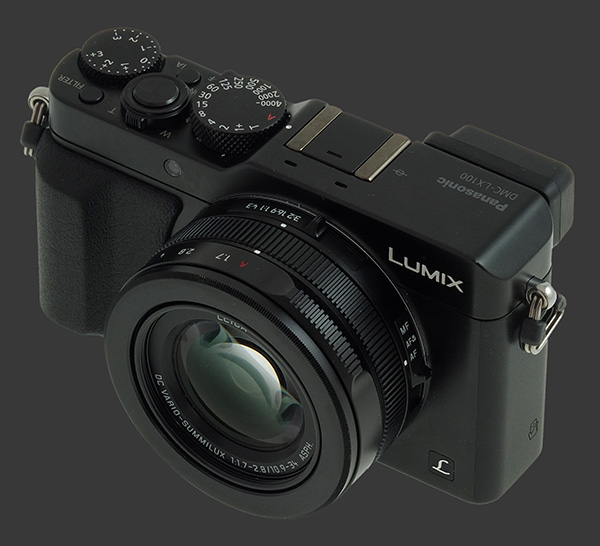
The aperture-ring is marked with A and full-stop aperture values from F/1.7 to F/16, although there are points for each 1/3 EV. The detent between A and F/1.7 is nice and firm but those between steps are slightly soft. There are tabs on opposite sides of the ring to provide a good grip on the otherwise smooth surface. Setting the aperture-ring to A lets the camera automatically choose aperture. Any other choice sets the aperture manually except that the widest apertures are ignored when zoomed-in.
A ribbed control-ring is found immediately behind the aperture-ring. This one turns smoothly without steps too easily. Even with care, turning it accidentally happens often. This is a fly-by-wire ring which is used for Manual Focus. In AF mode, it can control the zoom, ISO, WB, Special Effect Filter or left unused. At least, when set to zoom, it is immediately noticeable when the control-ring is turned inadvertently.
Still on the lens barrel, just behind the control-ring, there are two switches. The one on top selects the aspect ratio of images captured by the LX100. There are four options: 1:1, 4:3, 3:2 and 16:9 which correspond to a square image, the aspect-ratio of fixed-lens camerasNearly all fixed-lens cameras capture 4:3 images natively. Exceptions are ones with large sensors such as the Fuji Finepix X100 and the Sigma DP-series., the standard aspect-ratio of ILCsAll DSLRs and mirrorless except those by Olympus and Panasonic use the same 3:2 aspect ratio. and the aspect-ratio of typical wide-screen HD televisions, respectively.
The slider encourages changing the aspect-ratio to fit the scene. It has very firm detents, so it requires a good push which nearly always causes the control-ring to turn at the same time. The resolution changes slightly with the aspect-ratio, delivering a minimum of 10 MP for square images and maximum of 12.5 MP for 4:3 ones.
On the side of the lens barrel is a 3-way switch to choose between Normal AF, Macro AF and Manual Focus. This one also has strong detents which unfortunately makes it easy to accidentally turn the control-ring too. When set to MF, the control-ring sets the focus-distance which optionally triggers MF-Assist or Focus-Peaking.
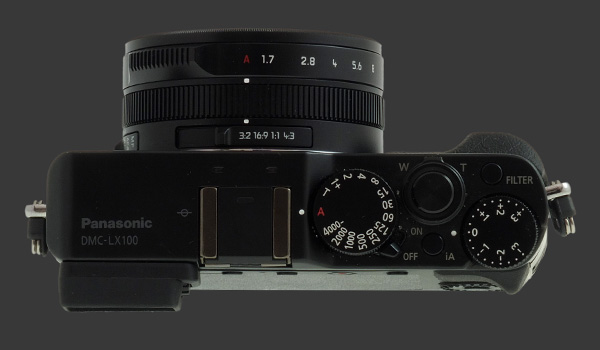
The top plate of the LX100 is split into two levels. The higher left side houses the 2.8 megapixels EVF, a standard hot-shoe and stereo microphone. Note the absence of a built-in flash. Panasonic does supply a small add-on unit which is powered by the camera. The lower right side has a shutter-speed dial above the power-switch, a shutter-release surrounded by a rotating zoom controller, an EC dial and two small buttons.
The shutter-speed dial is marked in full-stops from 1/4000 to 1s. It has good detents which are effective at preventing accidental changes. More shutter-speeds are accessible via the rear control-dial, described further down in this review page.
There is an A position which lets the camera select a shutter-speed automatically. Together with the aperture-ring, this provides all standard PASM exposure-modes. The T positions makes timed exposures up to 128s possible. Simply press the shutter-release to start an exposure and press again to stop. When T is selected, aperture defaults to F/16 and sensitivity yo ISO 200, if those are set to A.
The two-way power-switch below the shutter-speed dial has a nice positive action. Next to it, the small button labelled iA toggles fully automatic mode. This makes the camera ignore the aperture-ring and the shutter-speed dial. Exposure-Compensation is still possible though.
A standard two-stage shutter-release is mounted flat on top of the camera. While easy to reach, the strap eyelet on the grip-side of the camera digs into the base of the index finger. The release itself has short travel and a soft halfway-point, so expect some accidental shots.
The Exposure-Compensation dial is marked in ±3 EV in 1/3 stops. Like the aperture-ring detents, neither can be changed to ½ stops, which is common for dedicated mechanical controls. The real issue is that the EC dial has soft detents and often moves accidentally, several steps even at times. One has to constantly check the EC dial to avoid ruined exposures. At least, EC is also shown in most display modes.
The last button on the top-plate is a small round one which invokes a menu to choose special effects. The target audience for this camera is unlikely to use this, which leaves us perplexed as to why it is there and cannot be reassigned. The latter would be a welcome option if Panasonic added it via a firmware upgrade. Another improvement they could do is ignore control-ring changes while the aperture-ring or lens barrel slider-switches are moved. This would leave EC as the only notable ergonomic issue.
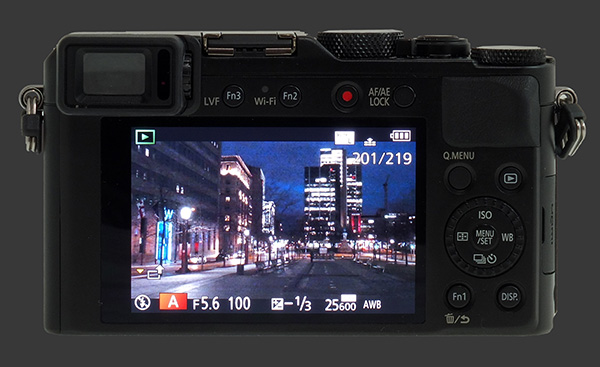
The back of the Panasonic LX100 is extremely busy. At the upper-left corner, there is a protruding 2.8 megapixels EVF with Eye-Start sensor. At 0.38", it gives 0.7X magnification at its native 16:9 aspect ratio. This is somewhat reduced at 3:2, then a little more at 4:3 and 1:1. The view is moderately large yet too small to confirm focus without MF-Assist.
There is a large 3" LCD with 920K pixels on the back. Like the EVF, it also shows 100% coverage but has a 3:2 aspect-ratio. This provides the largest viewing area for what is probably the most common aspect-ratio in photography. The display has a nice anti-reflective coating which works well outdoors. The LCD is highly customizable and can be calibrated in terms of Tint along 2 axis in 13 fine steps. Brightness, Contrast and Saturation are adjustable separately in 13 steps too.
The rear EVF and LCD show a bright view of the subject until the shutter-release is pressed halfway when it becomes Exposure-Priority temporarily. When the Live-Histogram is shown, it is calculated from the display brightness, making it useless until the shutter-release is pressed halfway. While it would be preferable to always have an Exposure-Priority display, the histogram should only be shown when correct. Instead, it simply turns an orange color while occluding part of the frame, making it worse than useless. At least it can be turned off completely.
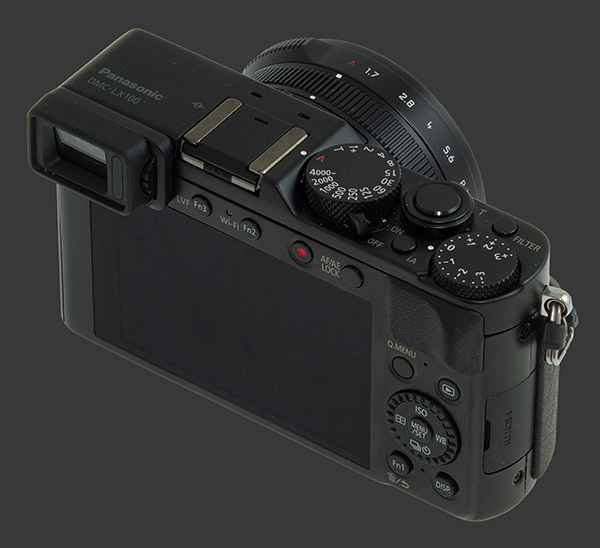
MF Assist, available on both the EVF and LCD, is very well implemented. It zooms in quickly and shows virtually no lag. The high magnification makes it easy to know which part of the image is in focus. Focus Peaking can optionally be added with 3 choices of color and 2 levels of sensitivity.
Four buttons are found directly above the LCD. The left-most two are customizable to one of a whopping 39 functions. Fn3 defaults to cycling between the EVF, LCD or Automatic Eye-Start Sensor switching. Fn2 defaults to invoking the WiFi menu. There is a dedicated Video Record button, marked by the universal red got. Note that there are no modes at all on the LX100, so this button is needed for video. The last control above the LCD is the combined AE-L/AF-L button.
A small rubber thumb-rest helps hold the camera. Just below, there is a Q.Menu button and a standard Playback one. The former brings up a graphical menu which can be highly customized. The latter works just as usual, entering and exiting Playback mode. The LX100 is Shooting-Priority and a quick tap of the shutter-release returns to Capture mode. There is no Review Only mode though, so the camera will not power-on using the Playback button.
Further down, there is 4-way controller with central Menu button, surrounded by a thin control-dial. The controller is used to navigate menus and activate important functions:
- Up: Selects the ISO. There are two automatic options, one depending on light levels and the other, called Intelligent ISO, depending on light and subject movement.
- Right: Selects White-Balance, including Kelvin temperature and two Custom WB memories. Both WB Fine-Tuning and Bracketing are accessible from there.
- Down: Selects the Drive mode, including Single-Shot, Continuous Shooting with four sub-options, AEB, Aspect-Bracketing, Self-Timers and Sweep Panorama. There is one 2s Self-Timer and two 10s ones, one which takes a single shot and the other that takes three.
- Left: By default, enters focus area control mode. In this mode the directions move the focus area around until OK is pressed. This can be customized to perform one of 14 functions instead, including selecting the Metering mode.
The rear control-dial is used mostly to refine the shutter-speed. Since the upper dial is marked in full-stops, the rear dial can adjust shutter-speeds ±2/3 stops. It can also select additional shutter-speeds at both ends of the range. When the upper dial is set to 1/4000s, the rear dial can choose speeds up to 1/16000s. With the upper one at 1s, it can select exposures up to 60s.
There are two below the 4-way controller: Fn1 and Disp. The former is used to delete images in Playback mode, while the other cycles between display modes. In Capture mode, Fn1 can be customized to access one of the same 39 functions as Fn2 and Fn3, described above.
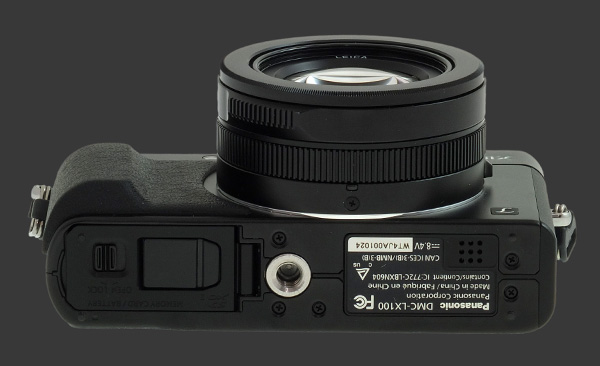
The bottom of the LX100 has a rather poorly placed tripod mount and a flimsy door covering the combined battery and SDXC card compartment. The remainder of the camera is actually well-built and feels solid though.
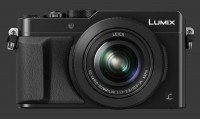 |
Please Support Neocamera
All information on Neocamera is provided free of charge yet running this website is a huge endeavor. Purchases made via affiliate links found throughout the site help keep it running and up-to-date. There is no additional cost to you, so please consider buying via these links to our affilates:
If you found any information on this site valuable and did not purchase via our affiliate links, please considering donating via PayPal:
Any amount will be greatly appreaciated. Thank you for your support!
Panasonic DMC-LX100 Highlights

Sensor-Size: 17 x 13mm

Actual size when viewed at 100 DPI
| 12 Megapixels Fixed Lens | ISO 100-25600 |
| 3.1X Ultra-Wide Optical Zoom | Shutter 1/16000-60s |
| Built-in Stabilization | Full manual controls, including Manual Focus |
| 0.38" Built-in EVF 2.8 Megapixels (0.70X) | Custom white-balance with 2 axis fine-tuning |
| Automatic Eye-Start sensor | Spot-Metering |
| 2 Axis Digital Level | Hot-Shoe |
| 11 FPS Drive, 8 Images | Lithium-Ion Battery |
| 3840x2160 @ 30 FPS Video Recording | Secure Digital Extended Capacity |
| 3" LCD 920K Pixels |
Updates
2024.04.03

Fujifilm X-T5 Review
Newest Fujifilm flagship boasting a 40 MP APS-C sensor, 5-axis IBIS with 7-stop efficiency, 15 FPS continuous drive, 6.2K Video capture, dual control-dials and dual SDXC UHS-II slots in a sturdy weatherproof and freezeproof body.
2023.11.20

Best Digital Cameras of 2023
Find out which are the Best Digital Cameras of 2023. All the new Mirrorless Digital Cameras from entry-level to high-end professional.
2023.07.10

Fujifilm X-H2 Review
40 Megapixels APS-C Hybrid Mirrorless Digital Camera with 7-stop IBIS. Fastest shutter ever and 8K video capture. Large builtin EVF with 0.8X magnification and 5.8 MP, plus an Eye-Start Sensor. Packed with features and large number of controls in a weatherproof and freezeproof body.
2023.05.07

Sony FE 20-70mm F/4G Review
Review of the unique Sony FE 20-70mm F/4G lens. The optical zoom of this lens spans ultra-wide-angle and medium focal-length coverage, making it one of the most versatile Full-Frame lenses on the market.
2023.01.15

Huion Inspiroy Dial 2 Review
Review of the Huion Inspiroy Dial 2 tablet, a medium sized drawing surface with dual dials and customizable buttons. Connects via USB-C or Bluetooth 5.0 with Windows, Linux and Android support.
2022.12.08

How to Pack for a Photo Trip
Find out how to pack for a travel photography trip, carry your gear safely while meeting airline regulations.
2022.11.13

Best Digital Cameras of 2022
The best digital cameras of 2022. A short list of the most outstanding models in their respective categories. Choose one for yourself or as a gift.
2022.09.21

Pentax DA* 60-250mm F/4 SDM Review
Review of the Pentax DA* 60-250mm F/4 SDM, the constant-aperture telephoto zoom with the highest zoom-ratio on the market.
2022.09.20

Pentax DA* 50-135mm F/2.8 SDM Review
Review of the Pentax DA* 50-135mm F/2.8 SDM, the lightest professional telephoto zoom native to the K-mount.
2022.09.10

Pentax DA* 11-18mm F/2.8 DC AW Review
Review of the Pentax DA* 11-18mm F/2.8 DC AW, the widest professional ultra-wide zoom native to the K-mount.
2021.11.24

50 Gifts Under $50 For Photographers in 2021
50 Gifts photographers will love. All for under $50 USD. 2021 Edition.
2021.11.17

Best Digital Cameras for 2021
Neocamera shows which are the very best Digital Cameras for 2021 in every category: Mirrorless, DSLR, Premium Compact, Ultra-Zoom and Rugged.












